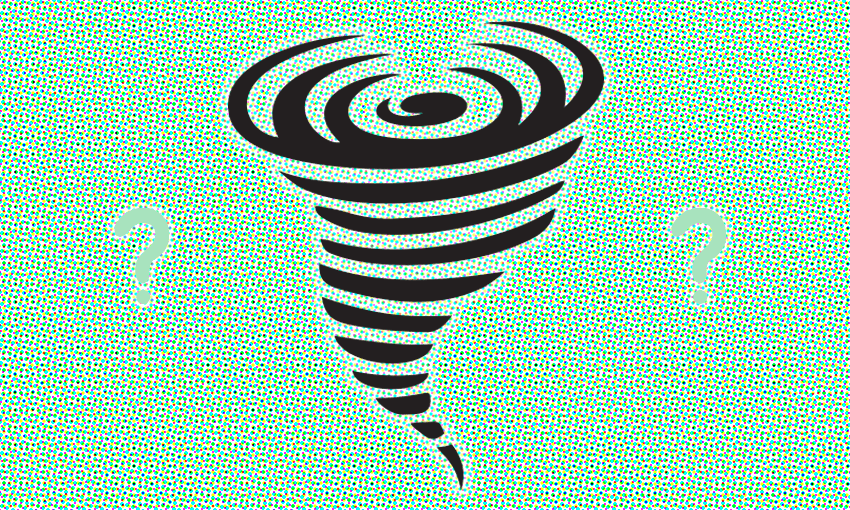Is four tornadoes in as many days as strange as it seems? We ask a meteorologist.
Watching the news this week has felt a little bit like we’re living in the Twister cinematic universe all of a sudden. Roofs ripped off, windows smashed, properties mangled – and all seemingly out of nowhere.
It’s because of a sudden spate of tornadoes, a weather event that once seemed totally alien here in New Zealand, but now appears to have become something of a regular occurrence. Since last week there have been four recorded across the country, in East Auckland, Tasman, Taranaki and on the Kāpiti Coast. Last year, meanwhile, a large twister tore up trees along the main road of Levin, leaving behind over $8 million in insurance claims.
And, according to the latest weather reports, more tornadoes could be on the way as stormy weather crashes into the country this week.
All these wild weather reports have led us to wonder: what the hell is going on? What even is a tornado? And why do they seem to be becoming more frequent?
Niwa’s Dr Richard Turner is a meteorologist with expertise in wind-related natural hazards. He was more than happy to help answer some of our most pressing queries.
What’s been causing this recent spate of tornadoes?
We’ll start with the most scientific question. According to Turner, our current tornado season can be blamed on something called “pre-frontal squall lines”. It sounds like something concerning you might find in a brain scan but it’s actually the name given to bands of thunderstorms embedded within unstable wind patterns. “The thunderstorms have very strong updrafts and if these occur in an environment in which the wind directions rotate counterclockwise as the air rises, the updraft can start to spin and a mesocyclone can form,” Turner explains. Mesocycle, in case you were wondering, refers to the obvious “vortex” that can be seen during a tornado. “Tornadoes are spawned from these mesocyclones, which can be as little as one to two kilometres across.”
Is climate change responsible?
It seems that climate change can’t really be blamed for these unusual weather events. In New Zealand, Turner says that most of our tornadoes occur in the “cold-season” and a recent study suggested that climate change would actually be more likely to trigger a reduction in cold-season tornadoes. “On the other hand, we suspect a link between La Nina and more activity in New Zealand, and if the frequency of La Nina events increases under climate change we might see more activity,” he added.
Have there actually been more tornadoes this year, or does it just seem like it?
Compared with the last few years, there certainly have been more tornadoes, Turner says. But that doesn’t mean it’s cause for concern. There have already been seven recorded tornadoes in New Zealand in 2023 – more than the totals recorded in each year between 2014 and 2021 (there were more – 10 overall – in 2022).
It’s not unprecedented, however. Turner says the numbers we’ve seen this year seem similar to the years 2007 and 2011, while the period between 1961 and 1975 likewise “seems to have been active”.
It can also be hard to know what is actually a tornado and what should be classified as a “water-spout”, Turner says, “and sometimes wind damage from downbursts have been attributed to tornadoes”.
Four tornadoes already in April – is that unusual?
Yes, says Turner, though tornadoes can occur any time of the year. “To me it seems a little unusual to have such events in April, as there is a tendency for these to be more frequent in the colder months which we are just coming into,” he says. “But they can occur in any month of the year.”
Weather reports suggest further tornadoes could be on the way. How are they predicted?
Meteorologists rely on forecasting the conditions within which tornadoes may appear, as opposed to being able to forecast the tornadoes themselves. That means they are looking for those particular wind patterns and thunderstorms referenced earlier. “At short-range or close to real-time… weather radars may pick-up the signature of severe thunderstorms… that could be a strong indicator that a tornado may occur,” says Turner. “However, oftentimes intense rain between a radar and a tornado could attenuate the signal and the tornado might not be detected.”
Most importantly: what should you do if a tornado is hitting?
Get low and seek shelter in or behind something solid. “You want to avoid being hit by debris,” explains Turner. “A bathroom is often advised as the plumbing in the walls may offer some protection.”



